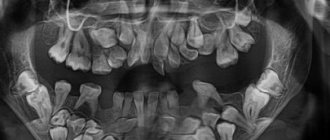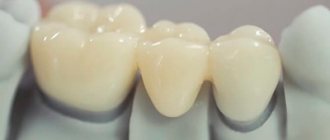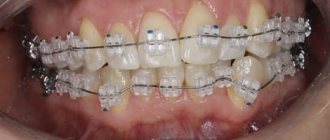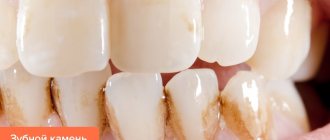Features of crown manufacturing
But the manufacture of prostheses also requires certain conditions. The most important thing is the correct selection of the metal sample. Both the survival rate and the hardness of the substance depend on this indicator. Gold itself is a soft metal; if you use 999 grade in dentistry, it will not last long. Such a sample is easily deformed when bitten, and also quickly wears off. Its cost is also too expensive for the average person.
But if you take a low-grade alloy, it will also not work, since there are requirements for the alloy. If there is too much ligature, its ions gradually accumulate in the body and cause side effects. Local metallosis (accumulation of metal in the gums and adjacent teeth) may develop. And also certain alloys, for example, zinc and nickel, cause allergic reactions and blackening of neighboring areas. And some alloys can be carcinogenic.
Dental crowns are made to order in specialized dental clinics. Their cost will depend on the dollar exchange rate, which changes daily. This is explained by the fact that banks supply the precious metal to clinics. In particular, this service is offered by Sberbank of Russia.
Dental technicians shape the ingots and add the ligature. By the way, a sample can be found on some of them. The crown itself consists of a disk, as well as an upper part made of gold.
Since such a crown is completely unaesthetic, the cost of its installation is low. Dentistry is the only place where the cost of ceramics is higher than precious metals. There are several manufacturing methods:
- Stamping. These are the so-called fixes. Their advantage is cost. And the disadvantages are expressed in the inconvenience of use, curvature of the bite, loose fit to the gums, which is why inflammatory processes appear. Casting. It has an anatomically more correct shape and a tight fit. Although it is also not included in the concept of “esthetic dentistry”.
Gold assay and use of prostheses
The gold prosthesis must be sterile. Such things are made from 900 or 750 samples. 585 sample is very rare. Pawnshops also accept crowns and pay money for it. Only the item itself must be cleaned of plaque and dental materials. You can't get a lot of money for teeth.
Vacuum installations for applying gold coatings to dentures
In the documents, dental precious metal is indicated as “scrap gold in the form of crowns or dentures.” When selling, you should also take into account that gold-plated teeth coated with a layer of precious metal are not accepted by pawn shops.
If you are interested in the reverse process, which involves turning a prosthesis into a product, this involves refining and remelting the metal. Many people do cleaning at home. There are also common cases when there is a need to convert jewelry into a prosthesis. But it won’t be possible to do this legally, since clinics only work with material officially purchased from the bank.
Precious metals are now practically not used for their intended purpose in medicine. Modern techniques in dentistry have come a long way from primitive dentures. The placement of such implants is not justified and even dangerous. This method will also not allow gold miners to get very rich.
Hochuzoloto/prochee/zubnoe-zoloto. html"hochuzoloto
Use of gold in dentistry: price per gram and sample of dental crown.
Gold has been used in dentistry for a long time. In ancient times, gold teeth were a luxury that not everyone could afford. Gold emphasized the fact that its owner was financially wealthy. But even today, gold does not leave dental clinics as a material, even despite the fact that the price of dental gold per gram is quite high. In some cases, for example, due to medical indications, nothing else can be installed except for gold crowns.
Gold is considered one of the most reliable metals in dentistry for a reason. It has strength and durability, and in combination with sufficient ductility, it can compete even with modern ceramic denture designs.
But not all dental clinics can afford to install gold materials. This is mainly the prerogative of state-level dental clinics, because to work with valuable metals you need to obtain a license, and it is quite difficult to acquire.
Most clinics only work with alloys that may contain gold.
Advantages and disadvantages of crowns
The advantages are obvious:
1. It is possible to restore even a complex tooth that is more than half destroyed.
2. A well-made and installed crown is almost impossible to distinguish from natural teeth.
3. Not only the appearance is restored, but also the chewing function.
4. The crown protects the remaining teeth from overload, premature wear and destruction, since the chewing “work” is distributed evenly.
5. There are fewer contraindications than with implantation.
However, installing and wearing crowns is associated with certain difficulties.
1. Grinding the tooth. Without this unpleasant procedure, it is impossible to install a prosthesis. But here the choice of construction material decides a lot - installation of a metal-free product is more gentle.
2. A crown cannot be placed if the tooth root is missing or destroyed. In this case, a bridge or implant is required.
3. The cost of poor preparation is too high. If the doctor poorly filled the canals, did not cure caries, or his actions led to a burn of the pulp, then inflammation will develop under the prosthesis.
Problems can be solved and difficulties overcome if you contact competent and experienced doctors.
How are gold teeth made?
According to the manufacturing method, they can be:
Stamped ones, as you might guess from their name, are made from standardized stamps - blanks. Their sizes are adjusted immediately before fixation in the dentition with dental cement mortar. Cast versions of prostheses are created separately - they are cast from gold using wax casts made in advance. They do not require any adjustment during installation, as they are pre-provided with the required dimensions. Accordingly, they are more expensive, and to install them, you need to sharpen the tooth enamel more than when installing stamped crowns.
What type of gold is used and how much does one crown cost? The answer is simple: gold is used from the 850th to the 900th standard. But often prostheses do not consist of pure metal, but of its alloy with copper and silver, which allows the prosthesis to be stronger. On average, the price per gram is about two thousand rubles. The entire dental crown will cost from ten thousand rubles. To compare prices, you can give the following table:
How much does a metal-ceramic crown cost in Ukraine?
Many patients are interested in how much it costs to install a prosthesis; It is clear that the cost of a metal-ceramic crown (one piece) and prosthetic services depends on the complexity of installation in each individual case, and the average price of a dental crown (prosthesis) made of metal-ceramics for 1 (one) tooth in “Dentistry from A to Z” (Kyiv, ...
Interesting materials:
Where is the deeper metro in St. Petersburg or Kyiv? Where do black-headed gulls nest? Where do herring gulls nest? Where is horizontal and vertical? Where is the most delicious coffee in the world made? Where and from what is sugar obtained? Where and how was the papyrus stored? Where and how did Nekrasov spend his childhood? Where and how was the film Eternal Call filmed? Where and how did Astafiev study?
Conditions for installing a gold crown
There are cases when dentures need to be installed only from gold:
- if it is necessary to accurately restore the previous shape of the tooth; for the restoration of teeth involved in the chewing process, which bear a large load; with a strong bite or a habit of strong clenching or grinding of teeth. to strengthen teeth; or simply to improve the aesthetic appearance of the row.
Accordingly, there are contraindications for installing gold crowns. They cannot be installed if:
- the patient is under 16 years of age; there is a disease - chronic periodontitis; the patient is mentally ill; the patient is pregnant.
Preparation and installation of gold dental crowns
The process of preparing and manufacturing a prosthesis consists of the following stages:
First, the tooth is prepared. He needs to be healthy, without caries. If necessary, carry out treatment, replace the filling, if it is old, if the tooth was on a pin, restore it, etc. Next, before starting the procedure, the tooth needs to be anesthetized. Now it has to be ground down to place a crown on it. Grind on each side, adjusting to the thickness of the crown being installed. Giving it the required shape, additionally small ledges are made for better fastening. After grinding, plaster casts of both the upper and lower dentition are made. Using the plaster version, a wax model of the crown is created, and then a gold prototype is cast.
Can I remove the crown myself?
If the integrity of the crown
not so important,
you can remove the crown
by simply sawing it.
This method often frightens patients, since the
preparation process is quite complicated. During filing, ultrasound is applied to the tooth, causing the material to crack, allowing the tooth to be freed.
Interesting materials:
How to get money from Tik Tok? How to get money from abroad? How can a young family get money for housing? How to receive money on a Privatbank card from abroad? How to get money via PayPal in Ukraine? How to get money on PayPal? How to get money to improve your living conditions? How to get money on webmoney? How to get money from an old savings book? How to get money spent on medicines?
Installation of a gold crown
Making a crown takes some time, so the patient is given a temporary one for the time being. Its task is to relieve a person’s unpleasant feelings and give the treated tooth temporary protection from damage and destruction.
When the permanent crown is made, the following is installed:
The crown is tried on and, if necessary, additional adjustments are made to size. Immediately before fixation, it is fully checked how correctly the teeth meet the crown, whether it fits tightly, etc. And only now it is fixed with special dental cement.
Procedure for installing a crown on a tooth
It doesn’t hurt to put a crown on a tooth at the MKS dental clinic in Kaliningrad: all manipulations are carried out under local anesthesia. The process includes the following steps:
- caries therapy, pulp removal, filling;
- production of gypsum unit variations;
- preparation of teeth (filing of tissue) and installation of temporary plastic crowns while the final structure is being manufactured using a plaster model;
- fitting process. Before placing a dental crown, the metal frame is measured and the veneer is applied;
- installation of permanent products subject to successful engraftment of temporary ones.
Advantages and disadvantages of dental gold crowns
Gold dentures, like any other, have their positive and negative sides. The advantages include the following:
- gold in any quantity has a beneficial effect on teeth, microflora in the oral cavity and even on the entire body as a whole; this metal is absolutely inert to components of saliva or food; when the jaws meet, gold dentures do not cause any destructive effects on the teeth in the opposite row, which prevents wear of the “native” teeth; gold is not an allergen and therefore does not cause allergic reactions; gold crowns are very strong and durable. They can withstand any chewing load created by the jaw muscles and will never break or even be susceptible to chipping.
Among the disadvantages of gold prostheses, it is worth highlighting the following:
- As you know, gold is a soft metal. Although the crowns will be strong and reliable, they will still begin to wear out over time; gold is a precious metal and therefore, given its high value, installation may be prohibitively expensive for some people; Only the side teeth look aesthetically attractive; the gold front teeth are unlikely to look beautiful.
In the first days after installation, many patients will feel discomfort. After the end of the anesthesia effect, the sensitivity of the crowned tooth often increases and it begins to react - sometimes to touch, sometimes to cold or hot food. But it’s easy to relieve these symptoms: if you have sensitivity to temperature, special toothpastes are usually prescribed, and if you experience pain while eating, the denture is usually lowered a little lower.
Prodragmetally /rynok/kotirovki-i-tseny/ispolzovanie-v-stomatologii. html" prodragmetally
Forum of the Russian Dental Portal - Dentistry for Everyone! .
Chieffa 08 Sep 2008
With enviable regularity, doctors hear the same question from patients: “Why, after installing crowns/inlays, does my head steadily pull down?” Or: “Which crowns are heavier: zirconium, metal-ceramic, cast, stamped? Because my teeth/gums are weak....”
The first five times doctors find it funny, then it’s no longer funny, and then they begin to think, “What if it’s really...?”
So, so that patients do not worry in vain, it will be useful for them to know: The average weight of one crown is 1.5 – 3 grams. The weight of the intra-root tab is 1.2 grams.
When chewing, the tooth experiences a load of 30 to 90 kg. So it doesn’t matter to the tooth whether a crown weighing 2 grams or 4 grams is on it!
For those who still feel that the weight acquired after prosthetics is pulling their head down, we can recommend having a haircut like this to move the center of gravity of the skull to its original place (longer at the back, shorter at the front).
Doc 14 Apr 2009
I had a MK bridge on my 4 upper incisors (6 years on temporary cement), they changed it to zirconium. It may be funny to doctors, but from personal feelings it seems that MK crowns are heavier. Not in the sense that it tilts the head forward. I don’t know how to explain correctly. Maybe it’s all a problem in the brain, or the bridge is of better quality, but it really has become easier
I think that if it stood for six years on temporary cement, then everything else in it was consistent with this fact. In addition, cast bridges have shrinkage, and as a result, if they are poorly seated, they can press and cause discomfort. Zirconium is milled and therefore does not give any shrinkage initially. And lastly, a good doctor will not make zirconium crowns into a six-unit bridge. Perhaps you now have them separately? In general, it's not about weight.
Tanata Apr 14, 2009
I think that if it stood for six years on temporary cement, then everything else in it was consistent with this fact. In addition, cast bridges have shrinkage, and as a result, if they are poorly seated, they can press and cause discomfort. Zirconium is milled and therefore does not give any shrinkage initially. And lastly, a good doctor will not make zirconium crowns into a six-unit bridge. Perhaps you now have them separately? In general, it's not about weight.
Not separately, unfortunately, I consulted 3 doctors, but the situation did not allow it. So maybe patients are actually not concerned about the weight of the crowns, but about these very sensations? But they can’t explain it properly. Doctors are driven to white heat with bad questions. And then similar topics arise.
Forum. stom /topic/3628-o-vese-koronok/» forum. stom
Gold crowns on teeth: how much do they weigh and how to clean?
Despite the active spread of various methods of prosthetics, metal prosthetics is the most popular. Therefore, in this article we will talk about gold crowns on teeth: how much do they weigh and how to clean them?
Note: They are performed like any other metal structures, but the result has higher final indicators.
In dentistry, products of different grades from 750 to 900 are used, depending on the type of prosthetics.
Types of crowns
- made of gold. They do not oxidize and do not cause inflammation and have some healing properties. The base is made of noble metal, coated with ceramics, thereby achieving the closest possible option to natural teeth. This base fits tightly to the gums and has a long service life - up to 15 years; made of an alloy of gold and platinum. Due to certain properties of the raw material, the crowns are quite thin and durable compared to the real composition. Due to such characteristics, an even tighter fit of the structure is achieved and a service life of up to 20 years is achieved.
Advantages and disadvantages
Dentures have a large number of positive properties:
- grinding of teeth is minimal due to the plasticity of the material and the density of installation; has a healing effect that prevents the development of an allergic reaction; metal corrosion does not form; Can be used on all elements, regardless of their location due to high strength; high aesthetics; their use does not cause tissue irritation; raw materials do not contain harmful substances; due to the equal expansion of gold and dentin, such crowns directly “get along”; there are practically no cases of breakdowns; the service life of this type of prosthesis is much higher than others; There is no abrasion of opposing teeth.
Important to know: In addition, the use of alloys or pure noble material is perfect for people who have general health problems: gastrointestinal, endocrine, allergic, etc.
In addition to a significant number of positive properties, this prosthetics has a number of disadvantages:
- Its biggest drawback is its high cost. This is due to the fact that the highest quality raw materials are used in prosthetics; it is possible for the base to show through, which can significantly damage the aesthetic result; increased wear of dentures.
Making crowns
Modern prosthetics with noble materials differs significantly from previously accepted ones. Today, ceramics are actively used to cover the base. The shine leaves only a light warm tint that shines through the ceramic mass.
There are two types of manufacturing of such structures:
Stamped, made from previously prepared cartridges. Their adjustment is carried out directly in the oral cavity shortly before final fixation. Cast structures are made according to the impression taken. Such designs do not require adjustment.
It should be taken into account that casting technology requires more grinding of the enamel.
Let's look at the manufacturing process itself:
- preliminary preparation (necessary treatment, tooth restoration, etc.); anesthesia; turning the enamel according to the required forms; taking impressions, and this procedure must be carried out with both jaws; making a preliminary model from plaster in the laboratory; According to the completed model, a design prototype is made; initial fitting with necessary adjustments; final consolidation.
Gold crowns - gold dental prosthetics
31.12.2018
Thanks to the achievements of modern dentistry, metal-free dentures are the most popular. But time-tested gold is not going to give up its positions.
Strength, ductility, durability are just some of the advantages of dental structures.
How to put gold crowns on your teeth, what grade of metal to use, features of installation and care - this and much more is discussed later in the article.
When can gold crowns be placed?
What types of gold crowns are there?
What does a gold crown look like? Externally, the structure is no different from your own tooth, but has a characteristic yellow color and a recess inside with which it is attached to the base. Depending on how the products are made, they come in two types:
- stamped - made from ready-made plates or sleeves of standard size. Refinement and adjustment are carried out after fittings. This type of prosthesis fades into the background, since after installation there are often gaps left,
- cast – completely copy the patient’s own tooth. They do not cause chafing of the gums and have a tight fit. They are made individually based on an impression.
The golden frame of the structure can be coated with metal ceramics. In this case, the prosthesis has a natural shade and does not differ from your own. This option, by the way, is more preferable, because the aesthetics are an order of magnitude higher.
What kind of gold is used to make prosthetics?
What standard of gold is used for dental crowns, and what are they made of? In dentistry, pure metal is rarely used - as a rule, the alloy also contains silver and copper. There are alloys with the addition of platinum or palladium. The fineness depends on the percentage of gold component in the product, which also determines its scope of application.
Gold purity (%)Where it is usedFeatures
| 916 | 91,6 | Used for the manufacture of inlays, single dentures, bridges | Has high corrosion resistance and hardness, easy to process |
| 900 | 90,0 | Same as in the previous version | Same as 916, but with greater hardness |
| 750 | 75,0 | In the manufacture of individual parts of removable dentures (clasps, hooks). Also suitable as solder for high grade elements | Has a low melting point |
| 583 | 58,3 | It is the basis for pins and other individual parts | Characterized by low corrosion resistance |
You can often hear the question: how much does a gold crown weigh on a tooth? The weight of the product is determined by its size, wall thickness, and degree of wear. On average, the weight of the structure ranges from 0.3-2 g. The product, which consists of several gold teeth in a row, can weigh up to 9-10 grams.
Indications for installation
Gold dental prosthetics
Indications for the installation of a gold crown are the following clinical situations:
- the need to restore the anatomical form and functions of the dentition units,
- strong bite
- restoration of chewing teeth,
- the aesthetics of the dentition is impaired,
- there is a habit of clenching teeth, grinding at night,
- allergic reactions to other materials.
Gold structures are most often the choice if the patient is intolerant to other materials used for prosthetics. In particular, classical metals - they often contain nickel, which is the highest allergen.
In what cases should such products not be installed?
There are also contraindications for use:
- the patient has not reached 16 years of age,
- period of bearing a child,
- the presence of mental disorders.
If there is an inflammatory process in the periodontal tissues, the installation of the prosthesis is postponed until complete healing.
How is production and installation carried out?
For installation, you must contact a dental institution.
To work with precious metal, any clinic must have a license, obtaining which involves some difficulties and requires appropriate training and experience as a specialist.
Therefore, there are only a few such clinics, and in most cases in private dentistry it is possible to install products containing gold only as one of the components of the alloy.
“I inserted gold teeth a long time ago. Gradually they wore off, and I began to look for where to put new gold crowns. It turned out that this is such a problem!!! They offer something, but as soon as it comes to the certificate, there is nothing... I was thinking about installing metal ceramics, but at the last moment I found a large clinic. The price, of course, is off the charts, but everything seems to be in order with the documents.”
Antonina, 65 years old
Crown installation has several stages
The manufacture and installation of gold dentures generally proceeds as follows:
- preparatory stage - consists of removing plaque on the tooth, treating caries, refilling and other measures,
- grinding your own tooth - giving it a cone shape, sawing out ledges in the neck area for a tight fit and compliance with the crown,
- taking impressions, transferring them to a dental laboratory,
- production of a prosthesis based on the impressions obtained,
- fitting, if necessary - correction (carried out in a laboratory),
- fixing the product with cement.
On a note! It is recommended to cover the prepared tooth with a temporary structure while the crown is being made. This will prevent it from exposure to external factors, reduce the likelihood of destruction, and reduce discomfort. If it breaks, then the prosthesis, which is being created in the laboratory at this time, simply will not fit.
Features of the recovery period
Sometimes sensitivity occurs during the rehabilitation period
After having gold teeth installed, the patient may encounter some problems:
- pain: most often they speak of incorrect placement of the structure. To fix it, you need to contact your dentist - if the crown “fits” poorly, then it may have to be redone. But if pain occurs months after prosthetics, then most likely an inflammatory process has begun to develop under the prosthesis - you need to take an x-ray and evaluate the condition of the dental tissues,
- the tooth becomes sensitive to external influences: it occurs if the nerve was preserved during preparation for prosthetics. To reduce sensitivity, you can use special care products (paste and rinse for sensitive teeth). But in general, it is better not to allow the pulp to remain under the crown, because nerve inflammation is a matter of time,
- weakening of fixation: may occur when the cement base is washed out. To prevent the development of infection under the material, you should consult a doctor as soon as possible,
- falling out of the structure: observed due to improper installation, poor fit, and washout of cement. Contacting a specialist will help resolve the problem.
Whether you can eat food immediately after installation depends on what cement mixture the doctor used to fix the prosthesis. If you need to wait a certain time, the specialist will warn you about this. It is recommended to exclude solid foods from the diet for several days to allow the tissues to adapt and prevent accidental biting of the tongue or cheek.
Benefits of gold dentures
Among the advantages of gold teeth are the following:
- gold has excellent biological compatibility with living tissues,
- the metal does not oxidize and does not affect the taste of food,
- gold ions, entering the digestive tract, help prevent inflammatory processes,
- as a rule, this material does not cause allergic reactions, especially if it does not contain foreign impurities,
- the ability of metal to contract and expand is similar to that of natural dental tissue, so the likelihood of cracks is minimized,
- such dentures are highly durable and resistant to chewing loads,
- the plasticity of the metal makes it possible to achieve a tight fit of the structure,
- over time, the material does not stain or darken,
- gold combines well with many other metals and materials; it can be used in different designs and individual elements.
Gold has excellent biocompatibility with living teeth
With high-quality hygienic care, products can last 20 years or more.
Disadvantages of gold designs
Gold teeth also have disadvantages. Firstly, as in the case of other materials, your own tooth undergoes serious processing, loses its enamel layer and a certain amount of hard tissue.
Secondly, the yellow color of the material does not allow the structure to be installed on the front row units due to aesthetic reasons. Therefore, gold crowns are most often installed on the chewing group.
And finally, due to the high cost, not every patient can afford a gold structure.
Product care
Caring for dental structures is not fundamentally different from caring for your own teeth. To clean them from plaque without scratching the surface, it is not recommended to use highly abrasive pastes. You should not use threads either, as the risk of violating the tightness of the product increases. An alternative in this case may be to use an irrigator.
After eating, you should rinse your teeth with plain water. In addition, experts advise periodically carrying out ultrasonic cleaning. The procedure does not harm the structure and helps restore the shine and smoothness of the surface. At the same time, the living tissues of the teeth are cared for.
How to clean a gold structure
If the structure falls out or is replaced with another material, the product can be returned to a collection point. However, before this, it must be cleaned of cement and tooth debris.
If the crown falls out, it can be cleaned and returned
How to clean a gold crown? Different methods are used for this:
- in stores selling dental products and equipment, you can purchase a special preparation that dissolves the remains of the cement mixture,
- plastic elements can be removed from the surface of the structure by heating over a burning burner,
- if there is a lot of cement, then it can be removed by gently tapping the product with a heavy object,
- a heated mixture of hydrogen peroxide, ammonia and liquid soap will help remove particles of the fixing composition. To do this, the product should be kept in the solution for a while and cleaned with a brush. After treatment, the prosthesis should be thoroughly rinsed with running water and wiped dry.
In general, the best way to clean a gold crown is to use the services of a professional. In the dental laboratory, the product is treated with fire and hydrochloric acid. As a result, gold restores its color, shine, and is cleared of foreign particles.
Removing crowns: nuances
How to remove a gold crown from a tooth or dentures without unpleasant consequences? To do this, you need to contact your dentist.
Correct removal of the structure can only be done with special tools and by sawing. The mechanism of action of the devices is based on air pressure (pneumatic) or mechanical destruction of cement (spring).
In addition, the product can be removed using a special ultrasonic device.
Before removing the crown, an X-ray of the tooth is required. If its condition is poor and there are indications for removal, the doctor can remove the structure along with the remains of the dental unit.
How much does it cost to install a gold crown?
How much a gold crown costs per tooth depends on several nuances: the sample, the presence of other metals in the alloy, the manufacturing method, the weight of the structure, the status of the clinic, and others. The price for one unit can average from 20,000 to 40,000 rubles.











